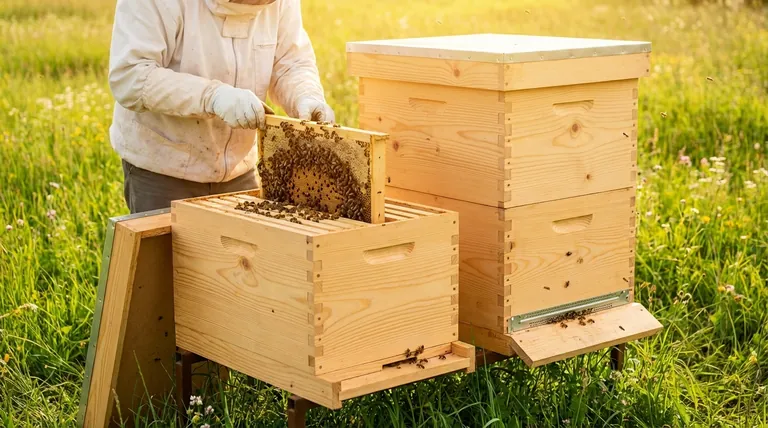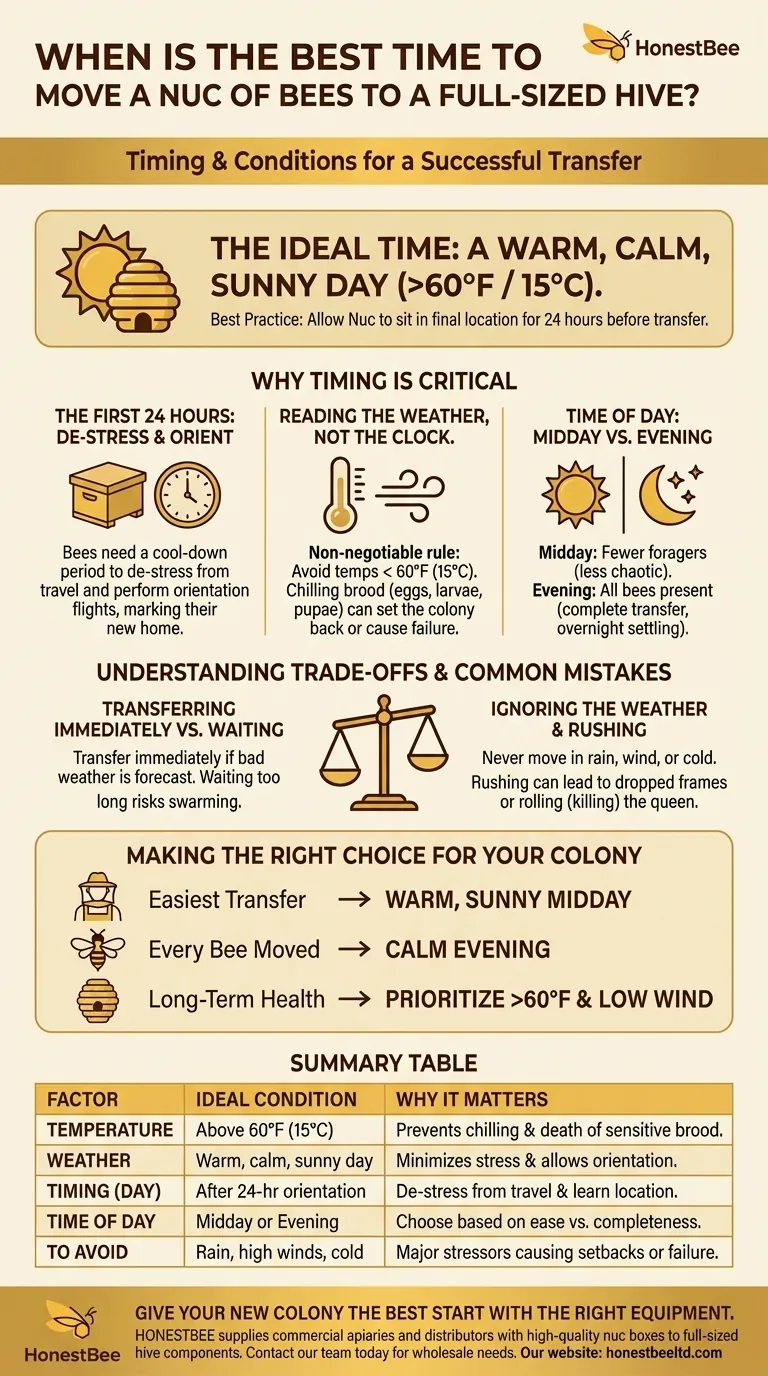Ultimately, the best time to move a nucleus colony (nuc) into a full-sized hive is on a warm, calm, and preferably sunny day when temperatures are above 60°F (15°C). While you can perform the transfer immediately upon receiving your nuc, it is best practice to let the nuc box sit in its final location for 24 hours to allow the bees to de-stress from travel and orient themselves.
The success of a transfer depends less on the specific time of day and more on providing ideal environmental conditions. Your primary goal is to minimize stress and prevent chilling the brood, which are the biggest threats to a new colony's survival and growth.

Why Timing is Critical for a Successful Transfer
Moving a colony is a significant and stressful event for honey bees. The timing and conditions under which you perform this move directly impact the colony's ability to recover, establish its new home, and begin thriving.
The First 24 Hours: De-stress and Orient
A nuc that has just been transported has been shaken, confined, and subjected to unusual vibrations and temperatures. They are in a state of high alert.
Placing the nuc box directly beside or on top of the permanent hive stand for about 24 hours gives the colony a crucial cool-down period. This allows the bees to perform orientation flights, marking the precise location of their new home and reducing confusion and absconding risk after the transfer.
Reading the Weather, Not the Clock
Weather is the single most important factor. Working the bees in poor conditions can set the colony back for weeks or even cause it to fail entirely.
The non-negotiable rule is to avoid temperatures below 60°F (15°C). Brood (bee eggs, larvae, and pupae) is extremely sensitive to cold. Exposing frames of brood to chilly air can kill it, forcing the colony to expend massive energy cleaning out dead brood instead of growing.
Time of Day: Midday vs. Evening
There are two schools of thought on the best time of day, each with valid reasoning.
A warm, sunny midday is often ideal. A large portion of the foragers will be out of the hive, meaning you are physically moving fewer bees. This makes the transfer less chaotic and reduces the number of defensive bees you have to manage.
A calm evening is the other option. At this time, all the foragers have returned home for the night. The main benefit is that you ensure every single bee is moved into the new hive. The colony also has the entire night to settle in and begin organizing the new space without disturbance.
Understanding the Trade-offs and Common Mistakes
A successful transfer is about balancing competing factors. Being aware of the risks helps you make the right call for your specific situation.
Transferring Immediately vs. Waiting
While waiting 24 hours is best practice, sometimes it isn't practical. If you receive your nuc on a perfect, warm day but the forecast calls for a week of cold rain, it is far better to transfer them immediately than to wait for a worse day.
The primary risk of waiting too long (more than a few days) is that a strong, expanding nuc can quickly run out of space. This can trigger swarm preparations, which is a problem you want to avoid.
Ignoring the Weather
This is the most common and damaging mistake a new beekeeper can make. Enthusiasm to get the bees into their new hive can lead to ignoring a forecast.
Never move a nuc in the rain, in high winds, or on a cold day. The risk of chilling the brood and stressing the colony is simply too high. A patient beekeeper is a successful beekeeper.
Rushing the Transfer Process
During the transfer, your movements should be slow and deliberate. The goal is to move each frame from the nuc into the new hive box in the same order and orientation.
Rushing can lead you to drop a frame or, even worse, to "roll" the queen. This happens when a bee (in this case, the queen) is accidentally crushed between two frames or a frame and the hive wall. Losing a queen is a catastrophic setback for a new colony.
Making the Right Choice for Your Colony
Your decision on when to transfer your nuc should be guided by one principle: creating the most stable, low-stress environment possible for the bees.
- If your primary focus is the easiest transfer for the beekeeper: Choose a warm, sunny midday when fewer bees are in the box, making the process simpler to manage.
- If your primary focus is ensuring every single bee is moved: Opt for a calm evening after all foragers have returned, but be prepared to handle a more populated hive.
- If your primary focus is long-term colony health (the correct focus): Prioritize a day with temperatures well above 60°F (15°C) and low wind, regardless of whether it's midday or evening.
By carefully choosing your moment, you give your new colony the best possible start in its new home.
Summary Table:
| Factor | Ideal Condition | Why It Matters |
|---|---|---|
| Temperature | Above 60°F (15°C) | Prevents chilling and death of sensitive brood. |
| Weather | Warm, calm, sunny day | Minimizes stress and allows bees to orient easily. |
| Timing (Day) | After 24-hour orientation period | Lets bees de-stress from travel and learn their new location. |
| Time of Day | Midday (fewer bees) or Evening (all bees present) | Choose based on your preference for ease vs. completeness. |
| To Avoid | Rain, high winds, cold forecasts | Major stressors that can set the colony back or cause failure. |
Give Your New Colony the Best Start with the Right Equipment
A successful transfer sets the stage for a thriving hive. HONESTBEE supplies commercial apiaries and beekeeping equipment distributors with the high-quality, durable supplies needed for every stage of beekeeping—from nuc boxes to full-sized hive components.
Let us help you build a stronger operation. Contact our team today to discuss your wholesale needs and ensure your bees have the best foundation for success.
Visual Guide

Related Products
- 5 Frame Wooden Nuc Box for Beekeeping
- Twin Queen Styrofoam Honey Bee Nucs Mating and Breeding Box
- Automatic Heat Preservation 6 Frame Pro Nuc Box for Honey Bee Queen Mating
- Styrofoam Mini Mating Nuc Box with Frames Feeder Styrofoam Bee Hives 3 Frame Nuc Box
- 5 Frame Langstroth Poly Nuc Corrugated Plastic Nuc Boxes
People Also Ask
- What are the benefits of starting a new bee colony in a nuc box? Boost Colony Success with Efficient Beekeeping
- How should the nuc be installed in the apiary? Ensure Colony Success from Day One
- What frames should be moved into the queenless hive when requeening with a nuc? Ensure a Successful Queen Introduction
- What are the benefits of using nucs for beginning beekeepers? Ensure a Successful First Hive with a Head Start
- How many frames does a typical wooden nuc box hold? A Guide to Choosing the Right Size



















